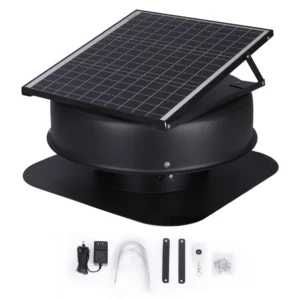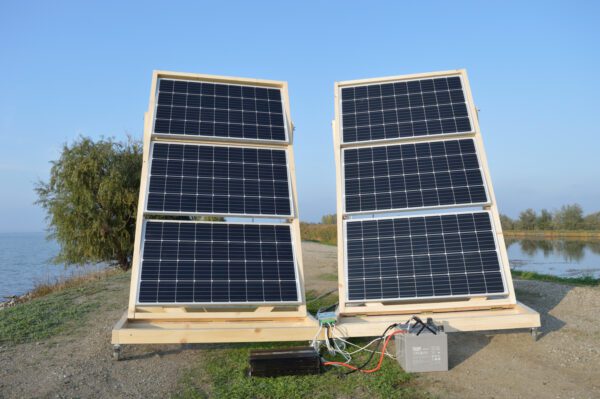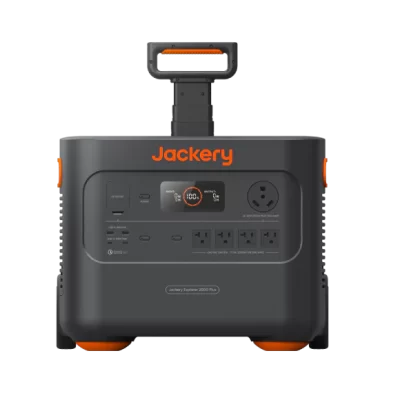Table of Contents
ToggleIntroduction:
As the world moves towards more sustainable sources of energy, harnessing power from the sun has become increasingly popular. With advancements in technology, solar energy at home is now more accessible and affordable than ever.
This guide will help you understand solar power. It covers its benefits and what to think about before installing solar panels at home. You will find a cost breakdown, steps for installation, incentives, and maintenance tips for your home solar system.
Introduction to Solar Energy at Home
Solar energy at home uses solar panels to turn sunlight into electricity. This electricity can power household appliances and devices. These panels can be installed on rooftops, walls, or ground-mounted systems.
Homeowners can use solar power to rely less on non-renewable energy. This helps lower energy bills and supports a greener environment.
More people have been using solar energy at home in recent years. This is due to lower costs for solar panels and equipment. Government incentives and rebates also help make it more affordable. As a result, more and more people are looking into solar power as a viable option for their energy needs.
Solar energy at home helps the environment. It also gives homeowners energy independence. This lets them control their energy use and costs.
Installing a solar power system at home can help you avoid rising energy costs. It also creates a more sustainable future for you and your family.
Understanding Solar Power and Its Benefits
Solar power is a clean, renewable source of energy that is derived from the sun’s rays. When sunlight hits the solar panels, the photovoltaic cells absorb it. These cells then change the sunlight into direct current (DC) electricity. An inverter changes DC electricity into AC electricity. This AC electricity can power your home.
One of the primary benefits of solar energy is its environmental impact. Unlike traditional energy sources like coal and natural gas, solar power does not create harmful emissions.
This means it does not contribute to climate change or air pollution. By switching to solar energy at home, you can significantly reduce your carbon footprint and help protect the environment.
Another advantage of solar power is its potential to save money on energy bills. Installing a solar power system at home has an upfront cost. However, the savings on electricity bills can quickly make up for this initial investment. Many homeowners find that their solar panels pay for themselves within several years.
There are also numerous financial incentives available for homeowners who choose to invest in solar power. Federal, state, and local governments often provide tax credits, rebates, and grants for solar energy systems. These can help reduce the cost of a home solar system.

VEVOR Solar Attic Fan
MPPT Solar Powered: Is it getting hot in your attic? A 40W MPPT controller can fully utilize sunlight to extract hot air from your attic. Our solar attic fan greatly reduces your cooling costs and is compatible with both metal and masonry roofs.
Factors to Consider Before Installing Solar Panels at Home
Before you decide to install solar panels at home, think about a few important factors. These factors can affect how well your solar system works.
Sunlight Exposure: The amount of sunlight your home receives is crucial in determining the efficiency of your solar panels. Ensure that your home has adequate sunlight exposure, with minimal shading from trees or neighboring buildings. The direction and angle of your solar panels also play a role in maximizing sunlight exposure.
Roof Condition and Space: Your roof’s condition and available space are essential factors to consider before installing solar panels. Ensure that your roof is structurally sound and can support the weight of the solar panels. Additionally, there should be enough space on your roof to accommodate the size of the solar system you plan to install.
Energy Consumption: Analyze your household’s energy consumption to determine the size of the solar system you’ll need. By knowing how you use energy, you can pick a solar power system that fits your needs and saves you money.
Local Regulations and Permits: It’s essential to familiarize yourself with local regulations and requirements for solar panel installations. Some areas may have specific permitting processes or restrictions on installing solar panels. Make sure to research and comply with these regulations to avoid any issues.
Solar Switch Review
A Comprehensive Guide to Solar Energy at Home
Before diving into the cost of solar panels, it’s essential to understand the components of a home solar system. A solar switch review can help you make an informed decision about the right solar system for your home. A typical home solar system includes:
Solar panels are the most visible part of a solar system. They convert sunlight into electricity. Solar panels come in various sizes, types, and efficiencies.
Inverter: The inverter changes the DC electricity from the solar panels into AC electricity. This AC electricity can power your home. There are two types of inverters: string inverters and microinverters. String inverters usually cost less but might not be as efficient. Microinverters are pricier but can offer better performance.
Mounting system: This component secures the solar panels to your roof or ground-mounted system. It is important to pick a strong and dependable mounting system. This choice helps keep your solar panels safe and lasting longer.
Monitoring system: A monitoring system helps you check how well your solar panels are working. It ensures they run efficiently. Many solar power systems come with online monitoring platforms that provide real-time data on energy production and usage.
Battery storage (optional): A battery storage system is not required. However, it can store extra solar energy made during the day. This energy can be used at night or when there is little sunlight. This can help further reduce your reliance on grid electricity and provide backup power during outages.
How Much Do Solar Panels Cost?
The cost of solar panels for homes can vary. This depends on several factors. These include the size of the solar system, the type of panels, how complex the installation is, and where your home is located.
Generally, solar panel costs have been decreasing over the years, making solar energy more accessible and affordable for homeowners.
On average, the cost of solar panels for a home solar system can range from $15,000 to $25,000 before incentives and rebates. This cost includes the solar panels, inverter, mounting system, and installation labor.
Remember, this is just an average. The actual cost of your home solar system may change based on your needs and situation.

Cost Breakdown for a Home Solar Panel System
A Comprehensive Guide to Solar Energy at Home
To understand the cost of solar panels for homes, we need to look at the different parts and their costs. The cost breakdown for a home solar panel system typically includes:
Solar Panels: The cost of solar panels typically makes up about 25% to 30% of the total cost of a home solar system. The type, size, and brand of solar panels you choose can impact the overall cost. High-efficiency solar panels often cost more. However, they can produce more electricity per square foot. This is helpful for homes with small roofs.
Inverter: The inverter is responsible for about 10% to 15% of the total cost of a home solar system. As mentioned earlier, there are two types of inverters: string inverters and microinverters. String inverters usually cost less but may not be as efficient. Microinverters are more expensive but can perform better.
Mounting System and Installation Labor: The mounting system and installation labor make up about 25% to 35% of the total cost of a home solar system. The cost of the mounting system and labor can change. This depends on how complex the installation is, the condition of your roof, and any extra equipment needed.
Permitting, Inspection, and Interconnection: These costs account for about 5% to 10% of the total cost of a home solar system. These fees are associated with obtaining permits, inspections, and connecting your solar system to the grid.
Sales Tax and Extra Costs: Sales tax and other costs can increase the total price of a home solar system. These costs include shipping and equipment rentals. They can add 5% to 10% to the overall cost.
Determining the Average Cost:
A Comprehensive Guide to Solar Energy at Home
To find the average cost of a home solar power system, think about several factors. These include the size of the solar system, the type and brand of solar panels, the inverter, and any extra equipment or fees. Keep in mind that the average cost can vary widely based on your specific situation and location.
Once you know the average cost of a home solar power system, you can compare it to your energy bill savings. You should also look for any available incentives or rebates. You can decide if solar energy is a good investment for your home by comparing the costs and benefits.
Steps to Install Solar Energy at Home
Research and educate yourself: Learn about solar energy, its benefits, and the parts of a home solar system. Familiarize yourself with local regulations and requirements for solar panel installations.
Check your home’s solar potential: Look at how much sunlight your home gets, the condition of your roof, and the space you have. This will help you see if solar energy is a good choice for your home.
Check your energy use: Look at how much energy you use. This will help you decide the size of the solar system you need.
Choose a solar installer: Research and compare solar installers in your area. Look for licensed and certified installers with experience in installing solar systems. Read reviews and ask for references to ensure you choose a reputable installer.
Design and customize your solar system: Team up with your solar installer to create a solar system. Make sure it meets your energy needs and fits your budget. Choose the type and size of solar panels, inverter, and mounting system that best suits your home.
Get the necessary permits and approvals: Your solar installer will take care of the permits. However, make sure all permits and approvals are in place before installation.
Install your solar system: Once permits are obtained, your solar installer will begin the installation process. This typically takes several days, depending on the complexity of the installation.
Connect your solar system to the grid: Your solar installer will work with your local utility company. They will help connect your solar system to the grid. Once connected, you can start generating your solar energy.
Solar Energy Incentives and Rebates
A Comprehensive Guide to Solar Energy at Home
Homeowners can save money on energy bills. There are also many financial incentives and rebates for those who invest in solar energy.
Federal Tax Credits: The federal government gives a tax credit of 26% for the total cost of a home solar system. This applies to systems installed by December 31, 2022. This credit applies to both residential and commercial solar installations.
State and Local Incentives: Many states and local governments offer additional incentives and rebates for solar energy installations. These incentives can be very different based on where you live. Make sure to check what is available in your area.
Net Metering: Net metering is a billing system. It lets homeowners sell extra solar energy back to the grid. This can further reduce your energy bills and provide a source of income for your solar system.
Solar Renewable Energy Credits (SRECs): SRECs are credits for each megawatt-hour of solar energy generated by your system. These credits can be sold to utilities to help meet their renewable energy requirements.
Maintenance and Upkeep of Your Home Solar System
A Comprehensive Guide to Solar Energy at Home
Proper maintenance and upkeep of your home solar system are crucial to ensure optimal performance and longevity. Here are some tips to keep your solar system running smoothly:
Regular Cleaning: Keep your solar panels clean and free of debris to maximize energy production. Clean your panels regularly with water and a soft brush.
Annual Inspection: Schedule an annual inspection with your solar installer to identify any maintenance issues and ensure your system is operating efficiently.
Battery Maintenance (if applicable): If you have a battery storage system, keep it well-maintained. This helps it work better and last longer.
Monitor Energy Production: Track how much energy your solar system makes and uses. This helps you find any problems or inefficiencies.
Conclusion:
A Comprehensive Guide to Solar Energy at Home
Solar energy at home is a great way to reduce your use of non-renewable energy. It can help lower your energy bills and support a greener environment.
By learning about solar power, you can understand its benefits. You can also consider what to think about before installing solar panels. This will help you decide if solar energy is right for you.
The cost of solar panels might look high at first. However, you can save money on energy bills. There are also incentives available. This can make solar panels a smart investment.
If you follow the steps to install solar energy at home and maintain your system, you can enjoy solar power for many years.
As the world’s energy needs grow, using the sun’s power for a sustainable future is more important than ever. By using solar energy at home, you can help the environment. This choice also creates a better future for the next generations.
Ready to make the switch to solar energy at home? Contact a licensed and certified solar installer in your area to get started today.
Our Money Saving Recommendations:
A Comprehensive Guide to Solar Energy at Home
Affiliate Disclosure:
The links contained in this product review may result in a small commission. This goes towards supporting our research and editorial team and please know we only recommend high-quality products.
Note: This article is for informational purposes only and is not intended to diagnose, treat, or cure any disease. Always consult a healthcare professional before taking any supplement or making any changes to your diet or lifestyle.









